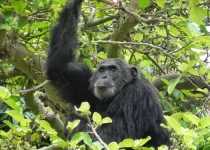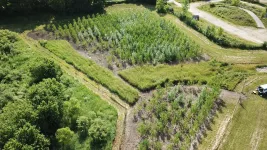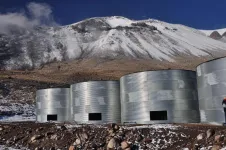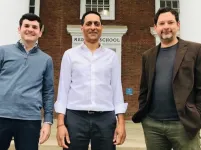(Press-News.org) Boston - This year, more than 60,000 adults in the United States will be diagnosed with pancreatic cancer and, statistically, as few as 10 percent will survive five years after diagnosis, according to the American Cancer Society. Because pancreatic cancer is hidden deep within the body and often symptomless, it's frequently diagnosed after the disease has progressed too far for surgical intervention and/or has spread throughout the body. Research indicates that earlier detection of pancreatic tumors could quadruple survival rates; however, no validated and reliable tests for early detection of pancreatic cancer currently exist.
Now, researchers at the Cancer Research Institute at Beth Israel Deaconess Medical Center (BIDMC) have successfully created the first three-dimensional (3D) organoid models of the pancreas from human stem cells. Unlike previous platforms for the study of pancreatic cancer, this first-of-its-kind organoid model includes both the acinar and ductal structures that play a critical role in the majority of pancreatic cancers. The new research platform -- which is not expected to guide patient care at this time -- will shed new light on the origins and development of pancreatic cancer, as well as reveal potential means for discovering markers of early diagnosis and monitoring the disease. The team's report appears in Cell Stem Cell.
"We thought, if we had a way to use human pancreatic cells to forward engineer cancer, we could begin to understand the earliest steps in the development of this disease," said corresponding author Senthil Muthuswamy, PhD, Director of Cell Biology at the Cancer Research Institute at BIDMC. "This model could also serve as a platform to potentially discover biomarkers -- measurable changes linked to disease -- that we hope to use in the clinic to monitor cancer development."
The pancreas is a hormone-secreting organ consisting of ducts and acinar cell, structures. Researchers suspect that the most common kind of pancreatic cancer (pancreatic ductal adenocarcinoma, or PDAC) arises in the cells lining acinar and ductal structures. However, until now, scientists have not been able to successfully grow and maintain human acinar structures in the lab challenging their ability to test the hypothesis in a model.
To coerce the stem cells down the path to becoming ductal and acinar cells, Ling Huang, Instructor or Medicine at BIDMC in the Muthuswamy laboratory collaborated with Doug Melton's laboratory at Harvard University and methodically tested various combinations of cell growth media used for different lengths of time. The culmination of five-plus years' of work, presented in the study represents the first time researchers successfully generated human acinar cells in culture and maintained them long enough to be able to use them in experiments.
"It's like a cooking recipe -- a complex recipe, with no precedent," said Muthuswamy, who is also Associate Professor Medicine, Harvard Medical School. "Only when you use all the right ingredients in the right proportions and do them in the correct sequence do you get the cells becoming the acinar cells."
Next, Huang and Ridhdhi Desai, a Research Fellow at BIDMC, used the two separate lineages of ductal and acinar organoids, engineered to include gene mutations known to be associated with pancreatic cancer. When the organoids were later implanted into mice, the different lineages behaved in distinct, predictable ways. For example, one mutation caused seven out of 10 of the mice transplanted with acinar-like organoids to develop cellular changes analogous to early pancreatic cancer in humans.
"Understanding the mechanisms that regulate these events will provide important insights into the events regulating the initiation of pancreatic cancer," said Muthuswamy, who stressed that direct use of this acinar organoid technology for patients who have cancer today may be limited. "The idea is to see if we can identify biomarkers to benefit future patients -- including by screening those at high risk for pancreatic cancer, so we can catch it before it's too late."
INFORMATION:
Co-authors also included Dipikaa Akshinthala, Christine Maria Lim, Raul Gonzalez, Lakshmi B Muthuswamy of BIDMC; Daniel N. Conrad and Zev Gartner of University of California San Francisco; Nayara Carvalho Leite of Harvard University.
This work was supported by Institutional startup funds and UO1 (CA224193); F32 fellowship (F32GM115201); seed grant from Hirschberg Foundation for Pancreatic Cancer Research; and R01 from NIGMS (R01GM135462).
The authors declare no competing interests.
About Beth Israel Deaconess Medical Center
Beth Israel Deaconess Medical Center is a patient care, teaching and research affiliate of Harvard Medical School and consistently ranks as a national leader among independent hospitals in National Institutes of Health funding. BIDMC is the official hospital of the Boston Red Sox. For more information, visit http://www.bidmc.org.
Beth Israel Deaconess Medical Center is a part of Beth Israel Lahey Health, a health care system that brings together academic medical centers and teaching hospitals, community and specialty hospitals, more than 4,000 physicians and 35,000 employees in a shared mission to expand access to great care and advance the science and practice of medicine through groundbreaking research and education. END
Every day, the sun ejects large amounts of a hot particle soup known as plasma toward Earth where it can disrupt telecommunications satellites and damage electrical grids. Now, scientists at the U.S. Department of Energy's (DOE) Princeton Plasma Physics Laboratory (PPPL) and Princeton University's Department of Astrophysical Sciences have made a discovery that could lead to better predictions of this space weather and help safeguard sensitive infrastructure.
The discovery comes from a new computer model that predicts the behavior of the plasma in the region above the surface of the sun known as the solar corona. The model was originally inspired by a similar model that describes the behavior of the plasma that fuels fusion reactions in doughnut-shaped fusion facilities known ...
Although plants may look fairly inactive to casual observers, research into plant biology has shown that plants can send each other signals concerning threats in their local environments. These signals take the form of airborne chemicals, called volatile organic compounds (VOCs), released from one plant and detected by another, and plant biologists have found that a diverse class of chemicals called terpenoids play a major role as airborne danger signals.
Past studies have shown that soybean and lima bean plants both release terpenoid signals that activate defense-related genes in neighboring plants of the same species, and this chemically induced gene activation can help the plants protect themselves from ...
It's well established that infectious disease is the greatest threat to the endangered chimpanzees made famous by the field studies of Jane Goodall at Gombe National Park in Tanzania. Now, new research led by scientists at Emory University shows that nearly half of the fecal samples from wild chimpanzees contain bacteria that is resistant to a major class of antibiotics commonly used by people in the vicinity of the park.
The journal Pathogens published the findings.
"Our results suggest that antibiotic-resistant bacteria is actually spreading from people to non-human primates by making its way into the local watershed," says Thomas Gillespie, senior author ...
Rhinelander, Wis., April 28, 2021-- A research team from the USDA Forest Service and the University of Missouri has developed a new contaminant prioritization tool that has the potential to increase the effectiveness of environmental approaches to landfill clean-up.
Phytoremediation - an environmental approach in which trees and other plants are used to control leachate and treat polluted water and soil - hinges on matching the capability of different tree species with the types of contaminants present in soil and water. Identifying the worst contaminants ...
LAWRENCE -- College students across the country struggle with a vicious cycle: Test anxiety triggers poor sleep, which in turn reduces performance on the tests that caused the anxiety in the first place.
New research from the University of Kansas just published in the International Journal of Behavioral Medicine is shedding light on this biopsychosocial process that can lead to poor grades, withdrawal from classes and even students who drop out. Indeed, about 40% of freshman don't return to their universities for a second year in the United States.
"We were interested in finding out what predicted students' performance in statistics classes ...
MINNEAPOLIS/ST.PAUL (04/28/2021) -- In a recent discovery by University of Minnesota Medical School, researchers uncovered a new way to potentially target and treat late-stage colorectal cancer - a disease that kills more than 50,000 people each year in the United States. The team identified a novel mechanism by which colorectal cancer cells evade an anti-tumor immune response, which helped them develop an exosome-based therapeutic strategy to potentially treat the disease.
"Late-stage colorectal cancer patients face enormous challenges with current treatment options. Most of the time, the patient's immune system cannot efficiently fight against tumors, even with the ...
Seasonally occurring fields of aufeis (icing) constitute an important resource for the water supply of the local population in the Upper Indus Basin. However, little research has been done on them so far. Geographers at the South Asia Institute of Heidelberg University have now examined the spreading of aufeis and, for the first time, created a full inventory of these aufeis fields. The more than 3,700 accumulations of laminated ice are important for these high mountain areas between South and Central Asia, particularly with respect to hydrology and climatology.
In the semi-arid Himalaya regions of India and Pakistan, meltwater from snow and glaciers plays an essential role for irrigation in local agriculture and hydropower generation. In ...
LOS ALAMOS, N.M., April 28, 2021--Analysis of data from a lightning mapper and a small, hand-held radiation detector has unexpectedly shed light on what a gamma-ray burst from lightning might look like - by observing neutrons generated from soil by very large cosmic-ray showers. The work took place at the High Altitude Water Cherenkov (HAWC) Cosmic Ray Observatory in Mexico.
"This was an accidental discovery," said Greg Bowers, a scientist at Los Alamos National Laboratory and lead author of the study published in Geophysical Research Letters. "We set up this system to study terrestrial gamma-ray flashes - or gamma-ray bursts from lightning - that are ...
New research from the University of Virginia School of Medicine has shed light on the No. 1 cause of epilepsy deaths, suggesting a long-sought answer for why some patients die unexpectedly following an epileptic seizure.
The researchers found that a certain type of seizure is associated with sudden death in a mouse model of epilepsy and that death occurred only when the seizure induced failure of the respiratory system.
The new understanding will help scientists in their efforts to develop ways to prevent sudden unexpected death in epilepsy (SUDEP). Based on their research, the UVA team has already identified potential approaches to stimulate breathing in the ...
Children and young adults with compromised immune systems, such as those undergoing cancer treatment, may experience a prolonged period of infection with SARS-CoV-2, the virus that causes COVID-19, and the extended duration of infection may increase the incidence of mutations. This case study was conducted by investigators at Children's Hospital Los Angeles and is published in the journal EBioMedicine.
Most people are infectious for about 10 days after first showing COVID-19 symptoms. In this study, researchers describe two children and a young adult with acute lymphoblastic leukemia who tested positive for SARS-CoV-2 for months. ...






